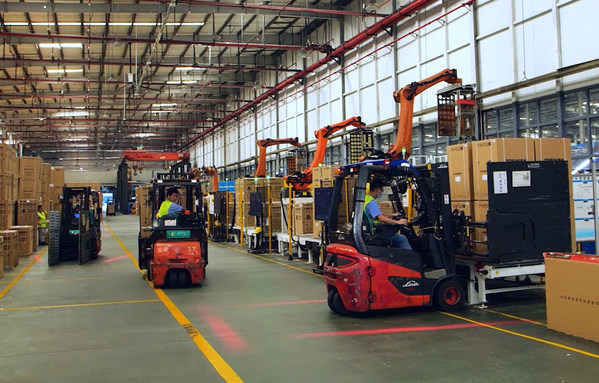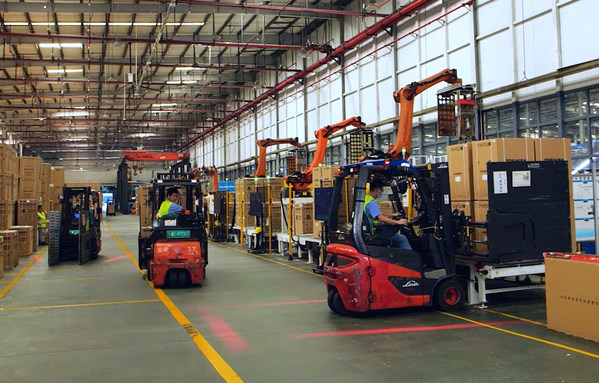Positioning as the most welcomed technology in the “Blooming Cup” Competition
BEIJING, Dec. 17, 2021 /PRNewswire/ — The 4th "Blooming Cup" 5G Application Pitch Competition was completed recently, which was organized by the China Academy of Information and Communications Technology (CAICT), IMT-2020 (5G) Promotion Group, and 5G Applications Industry Array. With the extensive development of 5G B2B applications in China, the competition has attracted broad participation from industries, businesses, and individuals. In 2021, 12,281 5G B2B projects participated in the competition. Industry Internet, smart campus, and smart city are the top 3 application areas. Positioning is the technology most adopted by the participating projects.
|
Technologies Adopted by the 5G B2B Projects Participating in the 4th Blooming Cup Competition |
|
|
Technology |
Adoption Rate in Participating Projects |
|
Positioning |
58% |
|
Big Data Analytics |
52% |
|
Edge Computing |
52% |
|
Cloud Computing |
51% |
|
Network Slicing |
47% |
|
Artificial Intelligence |
46% |
|
Uplink Enhancement |
38% |
|
5G LAN |
12% |
|
Source: CAICT |
|
The result indicates that vertical players have strong demands for positioning solutions in their 5G B2B applications. Since many vertical players have deployed 5G networks, could the 5G network be leveraged to improve the efficiency of the positioning service? Dr. Wang Jun, Chief Architect of Industrial Internet at Midea Group gave an answer from Midea’s point of view.
Fully Connected Factory
Midea Group is a Chinese household appliance manufacturer headquartered in Foshan, China. It has been listed on the Fortune Global 500 since July 2016. Midea produces lighting, water appliances, floor care, small kitchen appliances, laundry, large cooking appliances, refrigeration appliances, heating, ventilation, air conditioning, etc. It also owns KUKA, the world’s leading industrial robot manufacturer. In its manufacturing base in Foshan, more than 3,000 workers produce diverse appliances in the 160,000 square meters plant.
Since 2019, Midea Group has piloted 5G + Industry IoT applications in its manufacturing bases and started deploying the ‘fully connected factory’ in 2021. So far, Midea Group has collaborated with China Unicom Guangdong Branch to deploy a customized 5G network in its Foshan base. The network includes 16 macro base stations, 253 indoor small cells, and two sets of edge computing platforms. Industrial automation equipment, such as robotics, AGVs, machine-vision cameras, PLC controllers, etc., are connected through the customized network to the private cloud in Midea Group headquarters. As a result, diverse industrial automation applications have been implemented, including smart logistics.
Smart Logistics Not Only Means AGV
Unlike people’s imagination, even in today’s connected factory, the logistics system cannot entirely rely on an AGV system yet. The operation of an AGV system will require a high-precision positioning system that is often very expensive. On the other hand, many labor works are still necessary for a logistics system, e.g., most forklifts and trailers still need drivers, and the communications and coordination in the field cannot fully rely on AI assistants either.
Most commercial AGV systems today require a positioning precision at 1 cm level. For some exceptional cases, the 1 mm positioning precision will be needed. Either 1 cm or 1 mm positioning accuracy must rely on high-precision positioning solutions, such as laser radar or geomagnetic positioning. However, it will be too expensive for a factory to deploy these high-precision positioning solutions across the entire plant area and all vehicles.
In addition to AGVs, there are many other intelligent devices in a modern logistics system, such as machine-vision cameras, AR glasses, digital assistants of workers, etc. All these devices also need to be positioned, meanwhile need to be connected to the intra-network of the factory. The short-range wireless system, such as RFID, Bluetooth, or UWB, can provide the positioning service, but unfortunately, they cannot provide the necessary capacity of data connectivity. Wi-Fi system can meet the capacity requirement, but the mobility support for forklifts or trailers is still an issue.
5G at the Core of the Indoor Positioning System in a Fully Connected Factory
Midea Group’s fully connected factory illustrates how to leverage a 5G network to build a comprehensive positioning solution. The 5G network in its manufacturing base has become a common infrastructure for all industrial automation applications, which not only provides data connectivity for smart devices but also enables the positioning service across the entire plant area.
Now the 5G positioning technology can provide a positioning precision at the level of 1 meter. It is not as high as the precision of laser radar or geomagnetic positioning solution but is enough for a forklift driver in a warehouse. The 5G network on the campus can be a basic positioning layer across the plant. Other high-precision positioning solutions can be deployed in dedicated areas to facilitate the use of AGVs, robotics, or any other devices that require high-precision positioning. The two layers are integrated to form a cost-effective, comprehensive positioning system for the smart factory.
With the 5G positioning system, Midea Group significantly improves the efficiency of the warehouse operation:
- The average time to find goods is reduced by 80%.
- The warehouse labor efficiency is improved by 21%.
- The loading efficiency is improved by 55%.
The positioning system also plays a critical role in the overall smart factory operation. The 5G fully connected factory solution has helped the Midea factory in Foshan improve efficiency across the entire production process, which leads to a cost-saving of over RMB 30 million per year. Midea Group is now working with industry partners to test the low cost and low power consumption modules for 5G positioning to extend the 5G positioning service to containers, trays, and even workers.
With these developments, people expect the 5G positioning will be adopted by more vertical players and support broader industrial applications. As a result, 5G positioning will play a key role in the positioning system of vertical industrial applications and will be blooming in the 5G B2B market.




